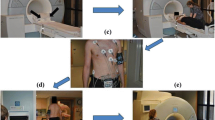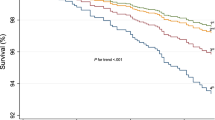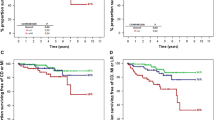Abstract
Background
Patients with an abdominal aortic aneurysm (AAA) have a high prevalence of coronary disease and are at risk for cardiac events. This may offset the prognostic benefit of surgical repair. We investigated whether preoperative exercise equilibrium radionuclide angiography (ERNA) could be used to identify patients at high risk for cardiac events after successful AAA repair.
Methods
Between 1990 and 1995, 173 patients with an AAA were referred for supine bicycle exercise ERNA preoperatively. Follow-up information was obtained from a questionnaire sent to each patient's family physician. Cardiac events were defined as cardiac death or nonfatal myocardial infarction.
Results
A total of 139 patients were able to exercise and did not die or suffer myocardial infarction perioperatively. The median follow-up period was 3.8 years. Diabetes mellitus, an exercise ejection fraction (EF) below 0.50, and a fall in EF with exercise were univariable predictors of cardiac risk during the follow-up period (P<.05). On multivariable analysis, diabetes mellitus (risk ratio [RR], 6.9; 95% CI 1.5 to 32.0) and an EF fall (RR, 4.1; 95% CI 1.5 to 11.4) emerged as the most important predictors.
Conclusions
Exercise ERNA predicts long-term cardiac events in patients being considered for elective AAA repair. Such predictive information may influence the decision to operate, for example, on small unthreatening aneurysms, or lead to invasive cardiological management to minimize risk.
Similar content being viewed by others
References
Hertzer NR, Beven EG, Young JR, O'Hara PJ, Ruschhaupt WF, Graor RA, et al. Coronary artery disease in peripheral vascular patients. A classification of 1000 coronary angiograms and results of surgical management. Ann Surg 1984;199:223–33.
Hertzer NR. Basic data concerning associated coronary disease in peripheral vascular patients. Ann Vasc Surg 1987;1:616–20.
Roger VL, Ballard DJ, Hallett JW, Osmundson PJ, Puetz PA, Gersh BJ. Influence of coronary artery disease on morbidity and mortality after abdominal aortic aneurysmectomy: A population-based study, 1971–1987. J Am Coll Cardiol 1989;14:1245–52.
Norman PE, Semmens JB, Lawrence-Brown MMD, Holman CD'AJ. Long term relative survival after surgery for abdominal aortic aneurysm in Western Australia: Population based study. BMJ 1998;317:852–6.
L'Italien GJ, Paul SD, Hendel RC, Leppo JA, Cohen MC, Fleisher LA, et al. Development and validation of a Bayesian model for perioperative cardiac risk assessment in a cohort of 1081 vascular surgical candidates. J Am Coll Cardiol 1996;27:779–86.
Poldermans D, Arnese M, Fioretti PM, Salustri A, Boersma E, Thomson IR, et al. Improved cardiac risk stratification in major vascular surgery with dobutamine-atropine stress echocardiography. J Am Coll Cardiol 1995;26:648–53.
Younis LT, Aguirre F, Byers S, Dowell S, Barth G, Walker H, et al. Perioperative and long-term prognostic value of intravenous dipyridamole thallium scintigraphy in patients with peripheral vascular disease. Am Heart J 1990;119:1287–92.
Hendel RC, Chen MH, L'Italien GJ, Newell JB, Paul SD, Eagle KA, et al. Sex differences in perioperative and long-term cardiac event-free survival in vascular surgery patients. An analysis of clinical and scintigraphic variables. Circulation 1995;91:1044–51.
Poldermans D, Arnese M, Fioretti PM, Boersma E, Thomson IR, Rambaldi R, et al. Sustained prognostic value of dobutamine stress echocardiography for late cardiac events after major noncardiac vascular surgery. Circulation 1997;95:53–8.
Shaw LJ, Heinle SK, Borges-Neto S, Kesler K, Coleman E, Jones RH. Prognosis by measurements of left ventricular function during exercise. J Nucl Med 1998;39:140–6.
Pasternack PF, Imparato AM, Bear G, Riles TS, Baumann FG, Benjamin D, et al. The value of radionuclide angiography as a predictor of perioperative myocardial infarction in patients undergoing abdominal aortic aneurysm resection. J Vasc Surg 1984;1:320–5.
Kazmers A, Cerqueira MD, Zierler RE. The role of preoperative radionuclide ejection fraction in direct abdominal aortic aneurysm repair. J Vasc Surg 1988;8:128–36.
Baron J-F, Mundler O, Bertrand M, Vicaut E, Barre E, Godet G, et al. Dipyridamole-thallium scintigraphy and gated radionuclide angiography to assess cardiac risk before abdominal aortic surgery. N Engl J Med 1994;330:663–9.
Lee KL, Pryor DB, Pieper KS, Harrell FE, Califf RM, Mark DB, et al. Prognostic value of radionuclide angiography in medically treated patients with coronary artery disease. A comparison with clinical and catheterization variables. Circulation 1990;82:1705–17.
Bonow RO, Kent KM, Rosing DR, Lan KKG, Lakatos E, Borer JS, et al. Exercise-induced ischemia in mildly symptomatic patients with coronary-artery disease and preserved left ventricular function. Identification of subgroups at risk of sudden death during medical therapy. N Engl J Med 1984;311:1339–45.
Iftikhar I, Koutelou M, Mahmarian JJ, Verani MS. Simultaneous perfusion tomography and radionuclide angiography during dobutamine stress. J Nucl Med 1996;37:1306–10.
Cates CU, Kronenberg MW, Collins HW, Sandler MP. Dipyridamole radionuclide ventriculography: A test with high specificity for severe coronary artery disease. J Am Coll Cardiol 1989;13:841–51.
Geleijnse ML, Elhendy A, Van Domburg RT, Cornel JH, Rambaldi R, Salustri A, et al. Cardiac imaging for risk stratification with dobutamine-atropine stress testing in patients with chest pain. Echocardiography, perfusion scintigraphy, or both? Circulation 1997;96:137–47.
Author information
Authors and Affiliations
Additional information
Dr Kelion is supported by a British Heart Foundation Junior Research Fellowship.
Rights and permissions
About this article
Cite this article
Kelion, A.D., Banning, A.P., Gardner, M.A. et al. Exercise equilibrium radionuclide angiography predicts long-term cardiac prognosis in patients with abdominal aortic aneurysm being considered for surgery. J Nucl Cardiol 7, 249–254 (2000). https://doi.org/10.1016/S1071-3581(00)70014-6
Received:
Accepted:
Issue Date:
DOI: https://doi.org/10.1016/S1071-3581(00)70014-6




